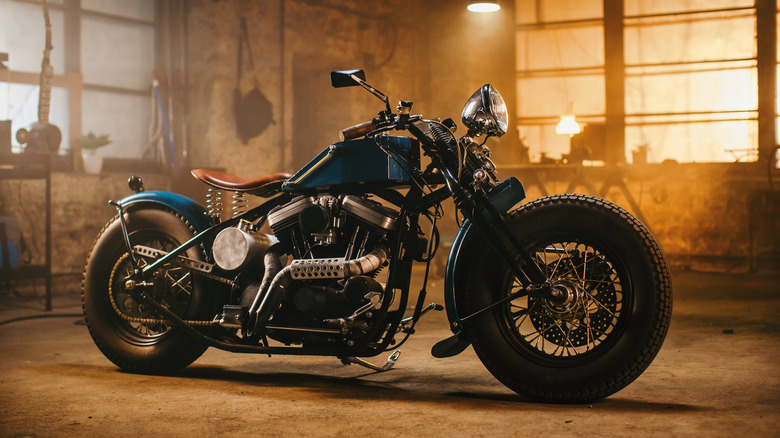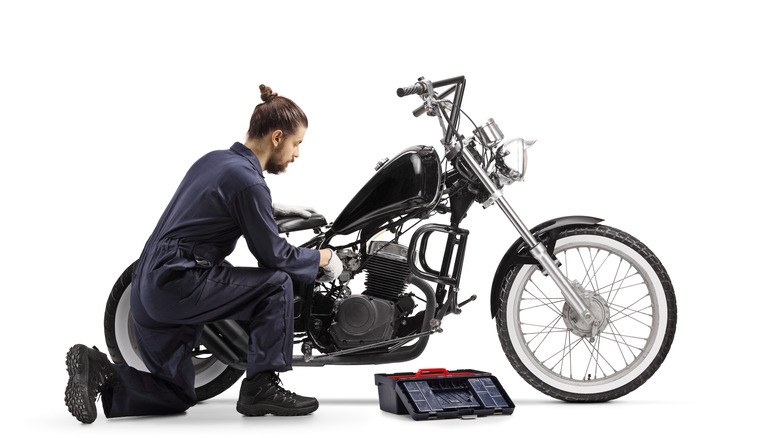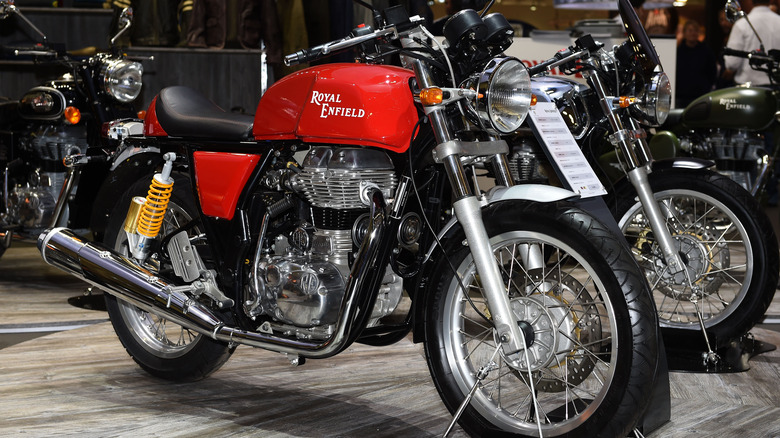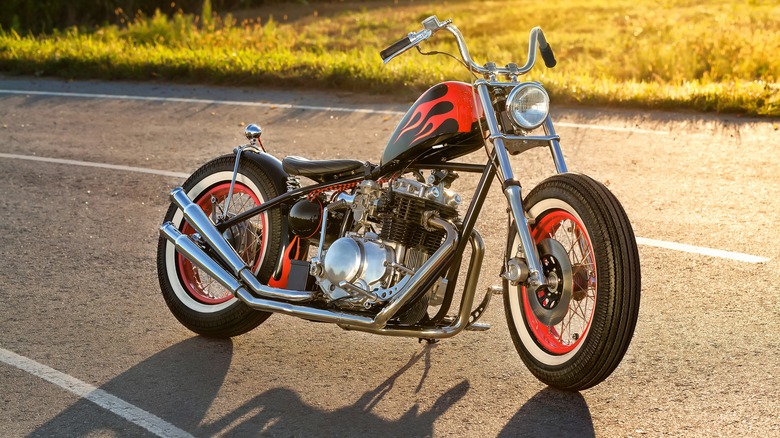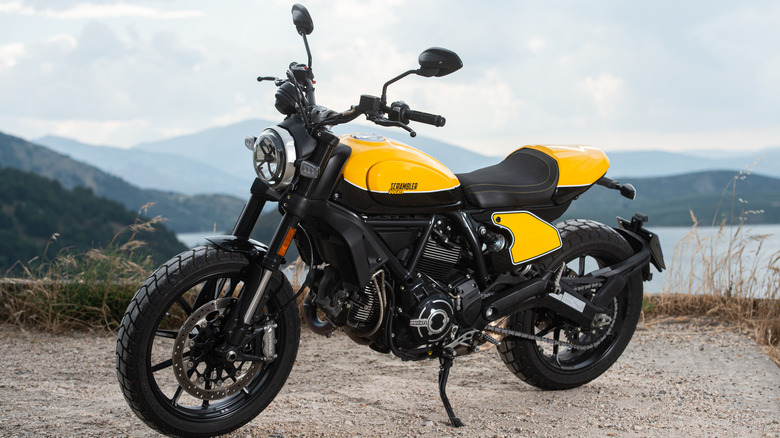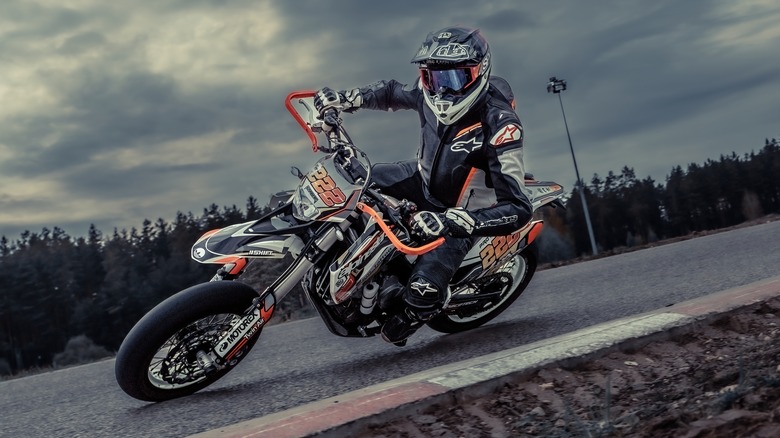Choppers, Bobbers, And More: A Guide To Motorcycle Customization Types
For many motorcycle enthusiasts, a bike is more than just a mode of transport — it's a symbol of their individuality. And what better way to express this than by customizing a stock bike? Modifying a motorcycle, whether it's through subtle enhancements that improve riding comfort or substantial aesthetic or performance upgrades, is a great way for bikers to make their ride their own.
Regardless of the type of customization you want to do, the key to getting it right is to understand your needs and then make changes that you're sure will enhance your riding or vehicle ownership experience. One way to come to terms with what you need out of your bike is by diving into the history of motorcycle customization styles through the decades. From the stripped-back Bobber to the adventure-oriented Scrambler, each style was designed to suit a particular riding style and visual aesthetic. Exploring these styles from the past — many of which have made a comeback — can provide you with all the inspiration you need and help you determine which styling elements best resonate with your preferences.
Chopper
Made famous by the hit Discovery Channel show, Orange County Choppers or O.C.C., Choppers are perhaps the most easily recognizable style when it comes to modified motorcycles. But Paul Sr. and company did not invent the look; it has a rich history that dates back to the post-World War II era in the U.S. The style came about after veterans who returned home from Europe stripped their motorcycles to just the essentials to create something reminiscent of the lighter models they used overseas.
Two of the most notable features of the Chopper are its elongated front fork and high handlebar. This was designed to create a more stretched-out look and laid-back riding stance, allowing the rider to have a relaxed cruising experience. These motorcycles also have a low seat and a tall backrest, which give them an aggressive look. Choppers are usually built by modifying existing cruiser motorcycles where unnecessary parts are removed or "chopped" off the frame — hence the name. They can also be put together totally from scratch, but you'll need a fully-kitted workshop, so it's not a cheap or easy hobby to get into.
The benefit of using an already assembled and working cruiser is that you aren't building it from the frame up, and only need the tools to do a minor teardown. Finding an old bike where you're just a fairing strip, grind, and paint job away from a new bike frees you up to test it out as you lose extraneous parts.
Café Racer
Café Racer-style motorcycles started making an appearance around the 1950s and '60s in the UK, inspired by the race bikes of the time. While it's not clear where the term "Café Racer" comes from, some believe it originated as a result of motorcyclists racing around a circuit, trying to finish a lap before the song at the nearby café was done playing. Over the decades, this style of motorcycle customization spread around the world, and it no longer refers to just British motorcycles.
Although they were traditionally built in garages or backyard sheds, they became so well-known and sought-after that major brands like Royal Enfield and Triumph designed and launched their own modern interpretations of the traditional design. In the past, these motorcycles were designed with distinct features that made them more performance-oriented and aggressive in appearance. For instance, Café Racers from back in the day often featured low-slung clip-on handles, a single seat, and rear-seat footpegs. Many models also featured a wasp tail that made it impossible for riders to install a pillion seat. While modern models may not look exactly like their predecessors, they still make for a quick ride while boasting more comfortable handling and seating.
Bobber
The origins of the Bobber can be traced back to the 1920s when people began moving away from the high, often expensive aesthetic of the time to a more basic design. During this era, people started cutting off bits and bobs or "bobbing" their bikes, and the result of this was a shorter rear section, a removed or shortened front fender, and cut-down frame. By the 30s, the Bobber started becoming more popular.
This customization style was essentially a product of riders wanting to enhance the speed and performance of their motorcycles. Cutting weight ultimately made it faster and contributed to its minimalistic look. Although it's not as comfortable as a standard motorcycle with its coil-spring seat, the performance aspects of a Bobber are what make it appealing to some riders. While they were overshadowed by Choppers in the '60s, Bobbers started making an appearance again in the 90s.
Although there are no rules for how Bobbers should be built, certain features are commonly seen in this design. Typically, most Bobbers have a single saddle seat (no seat for the pillion) and a rather barebones handlebar setup. Traditionally, riders would also strip their Bobbers of mirrors and headlights, too. If you're building a Bobber today, you can't do away with these essentials due to legal and safety regulations, but you can make modifications to enhance the performance of the motorcycle. If you're not keen on custom-building your own Bobber, consider purchasing one from a mainstream brand like Harley-Davidson or Triumph.
Scrambler
Scrambler motorcycles trace their origins back to the 1920s in England, where they were specifically modified to meet the demands of racing on different terrains. These races, called "scramble races" at the time, required motorcycles that could handle hilly terrain, muddy tracks, and more, and the Scrambler delivered on all those fronts.
Modern-day Scramblers can be identified by their tall suspensions and high exhaust pipes, stripped-down aesthetic, and spoked wheels that make them perfect for adventure riders. While they can be used on-road, their off-road capabilities make them ideal for people who want to ride on unpaved terrain. Despite its off-road capabilities, the Scrambler is one of the most practical motorcycle styles. In terms of riding position, Scramblers support a comfortable upright stance. This ergonomic riding position makes this motorcycle a good option for long-distance riding.
Also, unlike many customized styles, many Scrambler models have a pillion-seat squab, which means you can ride solo or with a pillion. Keep in mind, though, that the pillion seat may not be the most comfortable for long-distance rides. Still, you may be able to swap it out for a more comfortable aftermarket option. If you're not looking to custom-build a Scrambler, models from brands like Triumph and Ducati (if the expensive price tag doesn't put you off) may be worth considering.
Supermoto
Supermoto motorcycles combine the nimbleness of a motocross bike with the power and traction of a sports motorcycle to provide the rider with the best riding conditions on the asphalt. This style of motorcycle came about thanks to ABC's "Wide World of Sports," which featured "super bikers" who navigated tough racing courses with their modified motorcycles. The show resulted in fans creating a new customization style called the Supermoto, or SuMo.
These motorcycles have a unique design in that they're essentially dirt bikes that have been modified with 17" wheels, street tires, and upgraded brake calipers and rotors. The tall saddle, smaller wheels/rims, high ground clearance, and slightly stiffened suspensions contribute to the Supermoto's versatility and allow it to provide excellent handling and performance on different terrains.
Traditional Supermoto motorcycles are non-street-legal because they lack mirrors, lights, and indicators. If you'd like to ride your Supermoto on public roads, you will need to include these essential components in your custom motorcycle, or you could purchase a Supermoto-style motorcycle that is manufactured by a major brand. Thanks to this style of motorcycle customization becoming popular among enthusiasts, brands like KTM and Suzuki offer Supermoto or Supermoto-inspired motorcycles as part of their product line-up.
